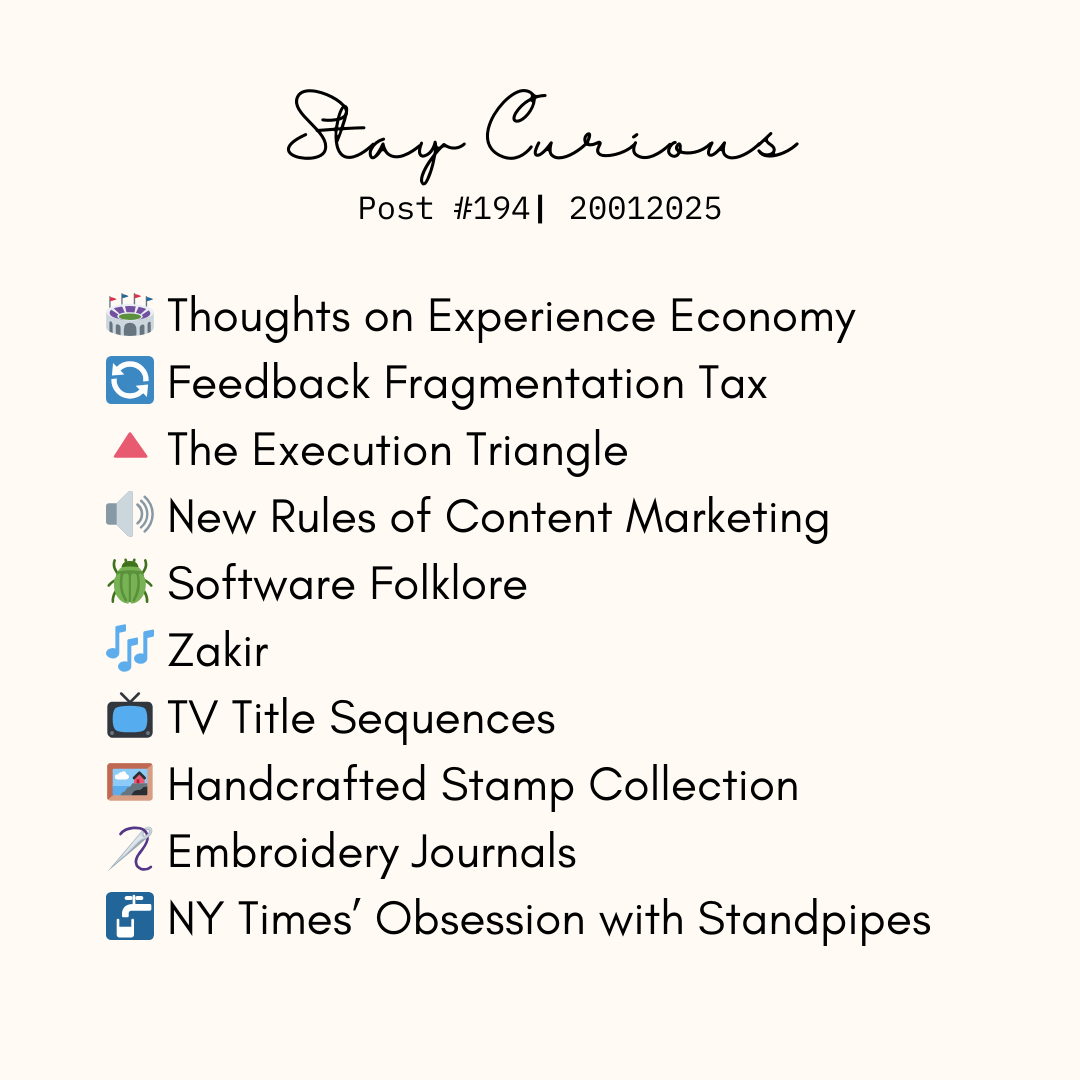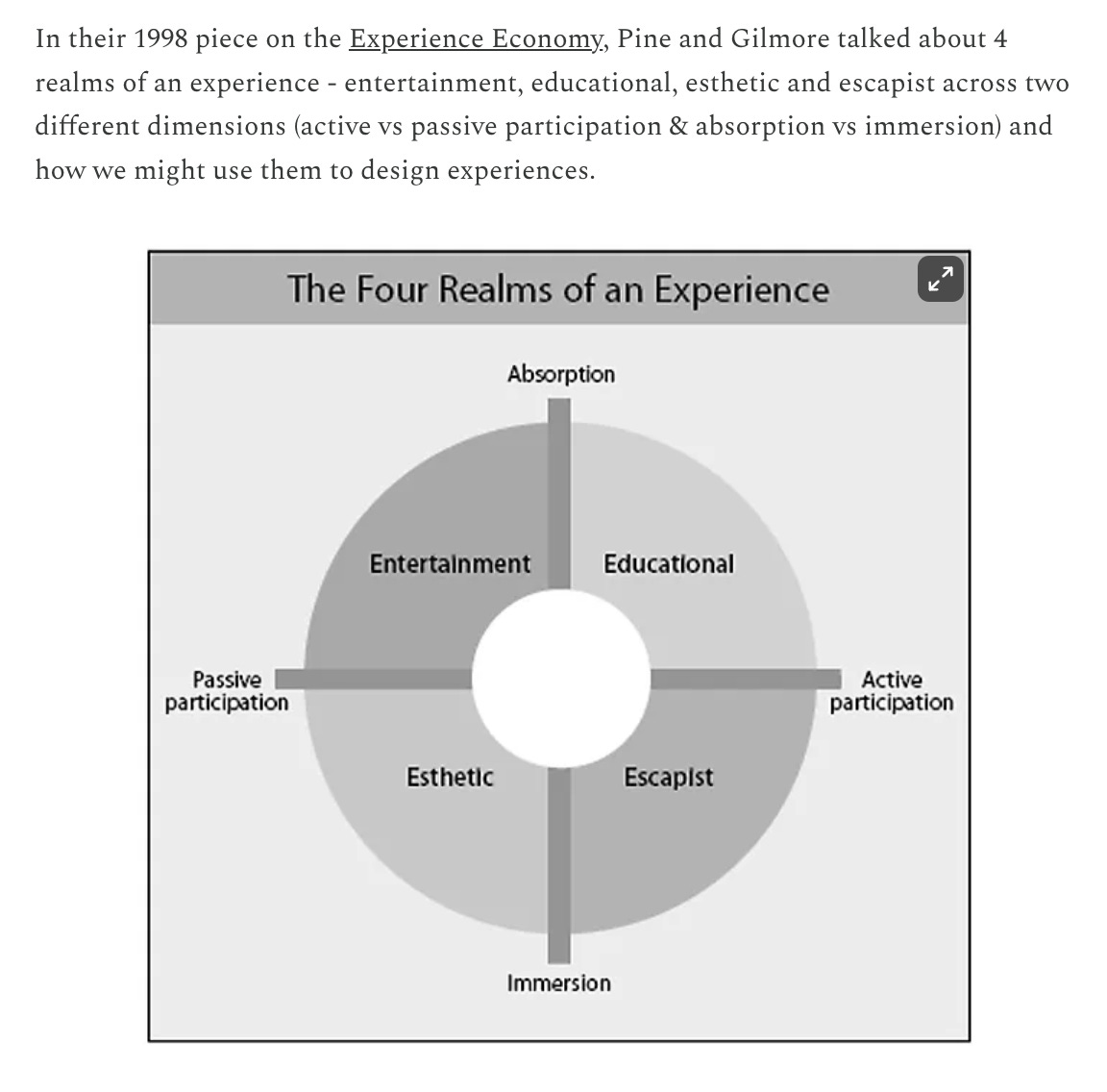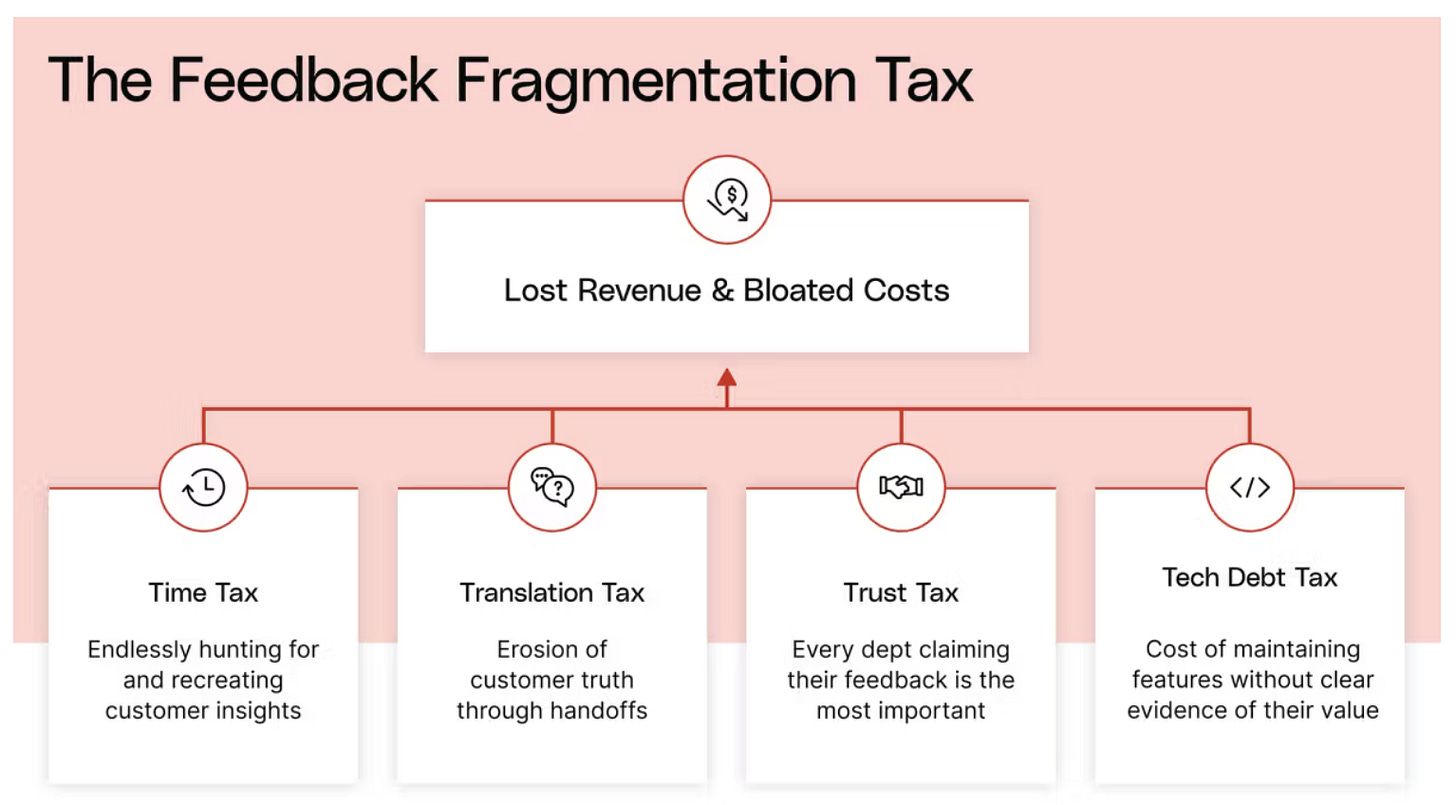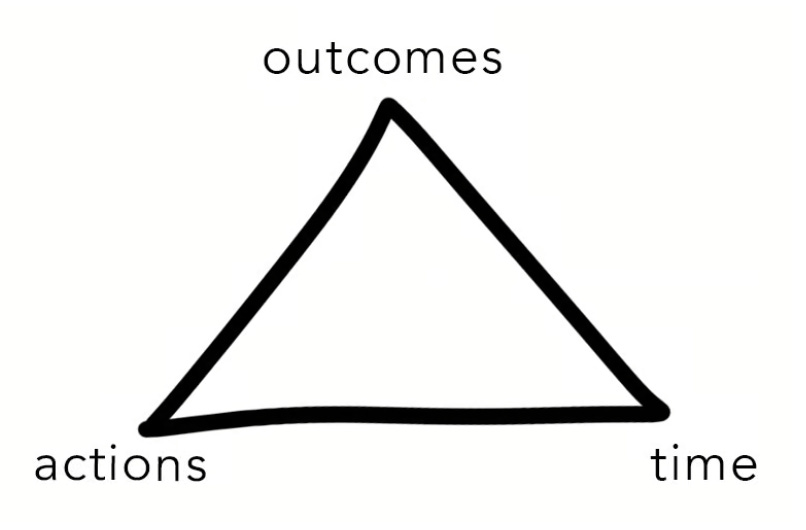📚 Experience economy, Feedback fragmentation tax, Execution triangle, Software folklore, TV title sequences
New rules of content marketing, Zakir, Tiny stamps, Embroidery journals and more
Hello, and welcome to post #194!
This week flew by in a blur, and the weekend felt just as hectic. Honestly, a three-day weekend is starting to sound like a necessity. Time’s been tight, so I couldn’t craft a long opening note—thanks for bearing with me on this!
No interesting photos this time, but I promise the lineup is just as exciting as ever. Take a quick look!
There is a lot to go over today, let’s get started…
🏟️ Thoughts on Experience Economy
Anmol Maini’s India “wants” experiences takes a high level dig at the rise of ‘experience economy’ in India. From Coldplay concerts to the pickleball boom, he highlights the rise of activities shaping this trend. While his exploration is brief, he touched upon a framework that’s particularly useful for deeper thought about this space.
Over the past year, through various discussions and explorations, I’ve developed a mental model for understanding India’s evolving “experience economy.” Here’s how I see it:
Two types of engagement activities:
Experience the activity (not necessarily social) – Live concerts, sports events, and similar experiences. These are aspirational, driven by affluence and a desire for prestige. They align with the Esteem and Self-actualization levels of Maslow’s hierarchy—we indulge in these because we want them.
Participate in the activity (with potential for social connection) – Pottery classes, walking tours, house parties, etc. These activities stem from the need to combat loneliness or break the monotony. They fulfill Psychological needs, Safety, and Love & Belonging—we engage in these because we need them.
This is still a work-in-progress framework, and I’m excited to refine it further as I delve deeper into this space. If this resonates with you, I’d love to exchange thoughts!
🔄 Feedback Fragmentation Tax
In “Feedback Fragmentation Tax”, the Reforge team touches on a critical issue faced by many product teams: we have more qualitative data, more tools, and possibly more owners. And still, we have less insights & worse product outcomes.
I’ve faced this issue, and I’m confident this will be familiar to many of you.
The article talks about four different types of tax stemming from feedback fragmentation and their impact:
They have described the symptoms associated with each ‘tax’, they are easily noticeable and highly prevalent. A good way to raise your awareness. You can identify which of these are relevant in your context & accordingly look to find the solution.
🔺 The Execution Triangle
Nir Zicherman posits that whenever you work on something, there are three primary levers you can pull:
Your Outcomes - What are you trying to achieve?
Your Actions - What steps will you take to get there?
Your Time - When do you need to finish it by?
That’s the Execution Triangle. He claims that you can only ever feel confident about two of these three levers. Any time you try to fix two of them, you’ll find the third grows elusive.
He shares excellent examples to clarify his point and help us pinpoint where we stand. A short yet insightful read!
🔊 New Rules of Content Marketing
Joe Lazer gets inspired from Kyle Chayka’s new rule of media and writes his version of ‘new rules of content marketing”. A couple of noteworthy observations:
5. Every substantial piece of text content should also be a video, and that content should be made by a savvy 23-year-old on their phone.
6. That video-savvy 23-year-old is the most important person on your team. Hire them today. They’ll keep you from getting old. It’s like having a blood boy for your content brain.
19. Original research and data storytelling still works. More people are creating content than ever, but fewer people are creating something new. Create the fuel that powers your industry’s content machine. Original research is surprisingly inexpensive — I just ran an in-depth survey of CTOs for less than $6K. But if you want it to take off, you need to package it in a way that’ll get attention — graphics, reels, and soundbites with a clear hook.
One of my biggest takeaways from this—and similar pieces, including my session with Paddy Upton—is that storytelling beats every other way of delivering a message. People crave solutions, but even more, they long to know they’re not alone in their struggles. Hearing someone’s story and discovering a solution within it brings the deepest sense of connection and buy-in you can hope for.
Authentic storytellers have a unique edge. Pair them with your experts (if the experts themselves aren’t already masterful storytellers), and you’ll have a strong chance of standing out in the crowded, AI-generated digital landscape.
(via Storythings)
🪲 Software Folklore
Speaking of stories, Andreas Zwinkau has curated a collection of Software Folklore—a treasure trove of quirky, unbelievable bug stories. Here’s how he puts it: “Sometimes bugs have symptoms beyond belief. This is a collection of such stories from around the web.”
If you’re into tech, you’ll love this for the sheer relatability—there’s a good chance you’ve heard some version of these tales during team discussions. Even if you’re not, these anecdotes shine as examples of great storytelling. They manage to teach timeless lessons about problem-solving and communication in the most engaging way possible.
My favorite so far are:
Car Allergic to Vanilla Ice Cream. What is there about a Pontiac that makes it not start when I get vanilla ice cream, and easy to start whenever I get any other kind?
The case of the 500-mile email. We can't send mail farther than 500 miles from here," he repeated. "A little bit more, actually. Call it 520 miles. But no farther.
More Magic. You don't touch an unknown switch on a computer without knowing what it does, because you might crash the computer. The switch was labeled in a most unhelpful way. It had two positions, and scrawled in pencil on the metal switch body were the words ‘magic' and ‘more magic'. The switch was in the ‘more magic' position.
(via Sidebar. Yes! Sidebar is back and is as good as I remember it.)
🎶 Zakir
The only memory I have of Ustad Zakir Hussain comes from the legendary Taj Mahal Tea advertisement. His mesmerizing tabla performance captivated the entire nation, sparking a newfound enthusiasm for percussion instruments, especially the tabla. News of his sudden passing shocked the world, and obituaries revealed facets of his life that many of us didn’t know.
Shruti Rajagopalan penned a heartfelt post capturing his unparalleled magic. Despite not being deeply into Indian music or understanding the complexities of creating it, I found her essay utterly captivating. Through stories and vivid descriptions, she brings his artistry to life, making even the uninitiated feel her joy.
Here’s an excerpt that truly encapsulates her writing:
Yet Zakir always filled the hall. The first few rows might have a last-minute printout marked “Reserved” or “VIP Seating,” and the rest fills up. Nobody worried about the fire code; the fire inspector is likely in the audience. Here, VIPs are typically the musical elite: other classical musicians or rasikas who have earned their stripes or inherited their VIP seats. Grateful Dead riffs do not feature in this setting. Instead, Zakir recites and explains complex thekas and chakradhars, describing in English or Hindustani the sounds he wants to evoke: a deer fleeing a hunter in the forest, a guest arriving for a meal, Lord Shiva’s damru, Lord Ganesha’s pakhawaj, and my favorite – the movement of the planets around the sun, a chakradhar he inherited from his father.
📺 TV Title Sequences
Have you noticed TV series title sequences evolving with fascinating new patterns?
James Poniewozik did and so he asks Why do TV Title Sequences have so much … stuff? In his NYTimes piece, he talks of a recent trend around the use of CGI to transform materials and substances into symbols that reflect the show’s themes. Think of The Rings of Power, The Last of Us, or The Ring of Power. The pattern is clear and intriguing.
While his analysis is surface-level, the examples he provides are engaging. For me, Game of Thrones and Mad Men stand out as memorable. I’d also add The Politician to this list —its visuals paired with Sufjan Stevens’ Chicago were unmissable!
Even in India, title sequences are getting more attention. Scam 1992 immediately comes to mind—its music and visuals left a lasting impression.
Which other ‘title sequence’ will you add to this list?
(via Storythings)
✨ Everything else
Laura K. Sayers' Stamp Collection is pure charm! Each intricate paper cut is a tiny masterpiece, carefully crafted into stunning miniature works of art. It's easily one of the most delightful things I've come across recently.
Sophie O'Neill's detailed Embroidery Journals chronicle all 365 days of the year. Such a visual treat! It’s always fascinating to see someone craft their unique way of preserving memories. Each tiny design holds a deeply personal story, evoking a spectrum of emotions. These creations become more than just art.
The dumbest thing I ever did that the New York Times wrote about. Answer is standpipes. Such a fun story and a great one around the art of noticing. And yes, NY Times folks are obsessed with standpipes! Check out the link inside taking you to their coverage over the years.
ICYMI…
Last week’s post was packed with some of the best discoveries I’ve come across recently. While “6 Hours with Paddy Upton” held a personal connection, “Getting slapped by a baguette” and “Pyramid of Game Design” stood out as my favorites. If you haven’t already, don’t miss checking them out!
That's all for this week, folks!
I hope I've earned the privilege of your time.
If you liked this post, please hit the ❤️ below and leave a comment to tell me more. Forward it to a friend who will find it useful, there is no better way to make this world more curious!








